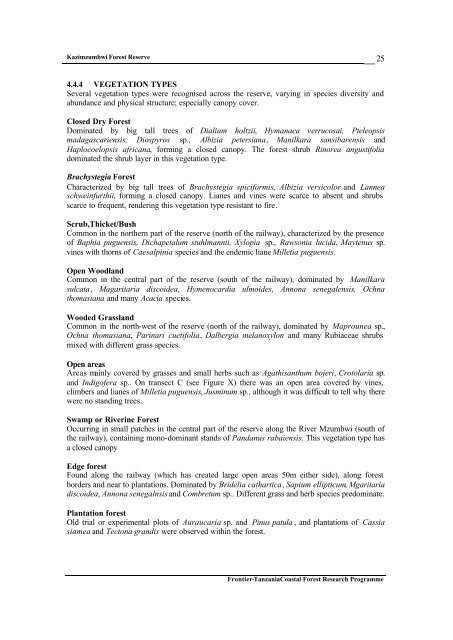Frontier Tanzania Environmental Research REPORT 110 ...
Frontier Tanzania Environmental Research REPORT 110 ...
Frontier Tanzania Environmental Research REPORT 110 ...
Create successful ePaper yourself
Turn your PDF publications into a flip-book with our unique Google optimized e-Paper software.
Kazimzumbwi Forest Reserve<br />
25<br />
4.4.4 VEGETATION TYPES<br />
Several vegetation types were recognised across the reserve, varying in species diversity and<br />
abundance and physical structure; especially canopy cover.<br />
Closed Dry Forest<br />
Dominated by big tall trees of Dialium holtzii, Hymanaea verrucosai, Pteleopsis<br />
madagascariensis, Diospyros sp., Albizia petersiana, Manilkara sansibarensis and<br />
Haplocoelopsis africana, forming a closed canopy. The forest shrub Rinorea angustifolia<br />
dominated the shrub layer in this vegetation type.<br />
Brachystegia Forest<br />
Characterized by big tall trees of Brachystegia spiciformis, Albizia versicolor and Lannea<br />
schweinfurthii, forming a closed canopy. Lianes and vines were scarce to absent and shrubs<br />
scarce to frequent, rendering this vegetation type resistant to fire.<br />
Scrub,Thicket/Bush<br />
Common in the northern part of the reserve (north of the railway), characterized by the presence<br />
of Baphia puguensis, Dichapetalum stuhlmannii, Xylopia sp., Rawsonia lucida, Maytenus sp.<br />
vines with thorns of Caesalpinia species and the endemic liane Milletia puguensis.<br />
Open Woodland<br />
Common in the central part of the reserve (south of the railway), dominated by Manilkara<br />
sulcata , Magaritaria discoidea, Hymenocardia ulmoides, Annona senegalensis, Ochna<br />
thomasiana and many Acacia species.<br />
Wooded Grassland<br />
Common in the north-west of the reserve (north of the railway), dominated by Maprounea sp.,<br />
Ochna thomasiana, Parinari cuetifolia, Dalbergia melanoxylon and many Rubiaceae shrubs<br />
mixed with different grass species.<br />
Open areas<br />
Areas mainly covered by grasses and small herbs such as Agathisanthum bojeri, Crotolaria sp.<br />
and Indigofera sp.. On transect C (see Figure X) there was an open area covered by vines,<br />
climbers and lianes of Milletia puguensis, Jusminum sp., although it was difficult to tell why there<br />
were no standing trees.<br />
Swamp or Riverine Forest<br />
Occurring in small patches in the central part of the reserve along the River Mzumbwi (south of<br />
the railway), containing mono-dominant stands of Pandanus rabaiensis. This vegetation type has<br />
a closed canopy<br />
Edge forest<br />
Found along the railway (which has created large open areas 50m either side), along forest<br />
borders and near to plantations. Dominated by Bridelia cathartica, Sapium ellipticum, Mgaritaria<br />
discoidea, Annona senegalnsis and Combretum sp.. Different grass and herb species predominate.<br />
Plantation forest<br />
Old trial or experimental plots of Auraucaria sp. and Pinus patula , and plantations of Cassia<br />
siamea and Tectona grandis were observed within the forest.<br />
<strong>Frontier</strong>-<strong>Tanzania</strong>Coastal Forest <strong>Research</strong> Programme

















